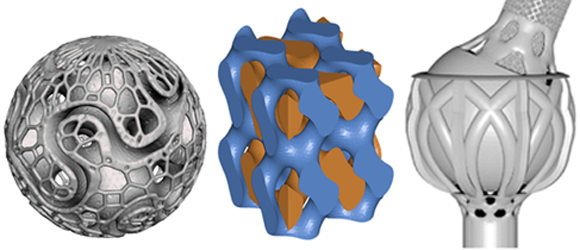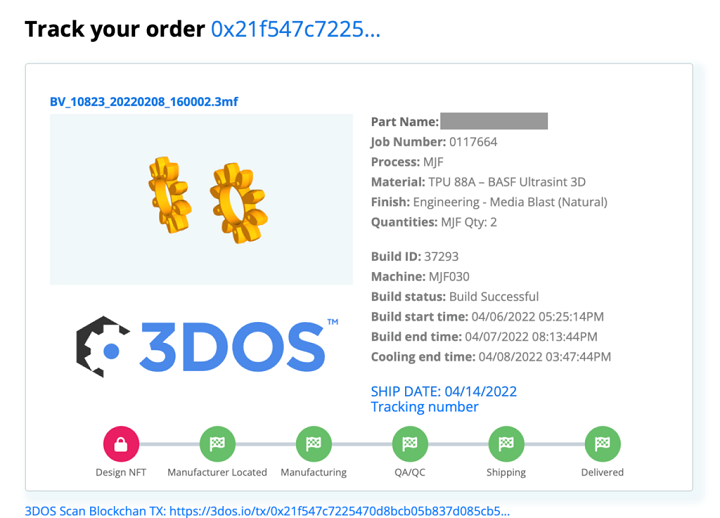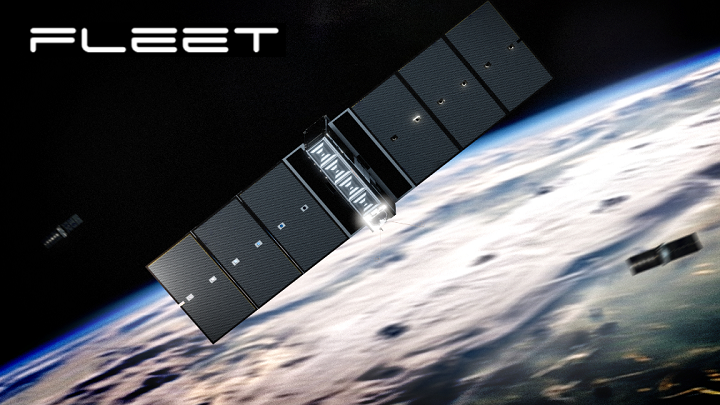In today’s 3D Printing News Briefs, 3DOS and Ivaldi are working together to deliver on-demand critical parts for heavy industries in Africa, and ASME published an AM design standard based on NIST research. 1016 Industries has introduced its Ferrari SF90 carbon fiber kit, and the Centauri 5 satellite was successfully launched with 3D printed patch antennas. Researchers studied the effects of 3D printed padding on mountain biking backpacks. Finally, Zaxe 3D Printing Technologies is making it easier to design and print using Paint 3D combined with its own software. Read on!
3DOS & Ivaldi Partnering to Deliver On-Demand Parts via Web3
The Ivaldi Group partnered with fellow Silicon Valley company 3DOS to securely deliver critical, 3D printed on-demand parts to heavy industries in Africa through the decentralized web3 network. With this integration, Ivaldi and its customers can enjoy protected royalties and an easier time getting 3D printed parts on-demand near their point of use. When a user needs a part, the 3DOS network instantly finds a local manufacturer and begins the on-demand print job, and the parts are protected as 3DOS NFTs, and then securely delivered through web3. In addition, the network facilitates global transactions and payments through decentralized finance (DeFi), based on secure distributed ledgers like the ones used by cryptocurrencies.
“We are excited to work with 3DOS, as they are building the world’s largest, decentralized on-demand manufacturing platform that will allow us to securely deliver critical parts to our customers anywhere around the world,” said Espen Sivertsen, the CEO of Ivaldi Group. “Their cutting edge work with DeFi protocols and the blockchain is opening up interesting new business models for OEMs and end users.”
ASME Publishes AM Design Standard Based on NIST Research

These 3D models exhibit many of the unique degrees of freedom afforded by Additive Manufacturing such as producing parts with complex geometry and made of multiple materials (Reprinted from ASME Y14.46-2022, by permission of The American Society of Mechanical Engineers)
A new standard, Y14.46, was recently published by the American Society of Mechanical Engineers (ASME), based on research by the National Institute of Standards and Technology (NIST). Traditional design language typically works for traditional manufacturing methods, but not as much for additive manufacturing, which means that information about AM designs can be lost in translation. The new standard is meant to help engineers more effectively communicate AM-specific considerations to manufacturers and product inspectors in design documents. Some concepts touched on in this standard include build process particulars, like orientation and 3D printed support structures, how to package 3D model-based data so it’s machine readable, and more.
“The industry is in a digital transformation right now, moving away from physical 2D drawings, and Additive Manufacturing is one of the catalysts since it requires digital 3D models. And if you’re working on one of those models, this standard will guide you in making it understandable to both 3D printers and other people,” said Fredric Constantino, an ASME project engineering adviser.
“Some of ASME’s other standards go ten years, twenty years without revision, but Additive Manufacturing is advancing so rapidly. We aim to keep pace by adding to this standard as time goes on. We expect it to evolve quickly.”
1016 Industries Launches Custom Carbon Fiber Ferrari SF90 Kit
Automotive aftermarket parts producer 1016 Industries, which specializes in carbon fiber 3D printing for high-performance exotics, has debuted its new custom carbon fiber kit for the Ferrari SF90. This “ultimate road car” by Ferrari, and its first to use EV, features full carbon fiber designs throughout to not only create a unique silhouette, but also enhance performance. These limited edition SF90 carbon fiber designs are available in a 1×1 weave or a premium 2×2 twill pattern, and can be made with special satin finishes upon request. Available parts are carbon fiber front bumper flaps, a front lip, hood vent system, rear diffuser, and side skirts. Additional 3D printed carbon fiber parts for the SF90 include a roof spoiler and special trunk spoiler. 1016 Industries is currently offering SF90 carbon fiber treatments for $51,200.
“Our approach to carbon fiber is that each part needs to smoothly work in harmony with the vehicle. At 1016 Industries, we design custom exotics that deliver something special to enthusiasts that are all their own when they get behind the wheel. We specialize in making special cars even more special. The 1016 Industries carbon fiber SF90 is made for elite collectors and immediately makes a statement when people see this rare Ferrari out on the road,” said Peter Northrop, the CEO of 1016 Industries.
Fleet Space Launches Satellite with 3D Printed Patch Antennas
Fleet Space Technologies successfully launched its next-gen Centauri 5 micro-satellite on the recent SpaceX Falcon 9 Transporter-5 mission, strengthening its leading spot in the Australian space tech industry. The 12 kg Centauri 5 features what Fleet Space believes is a world-first: a set of entirely 3D printed metal patch antennas, which the company claims can deliver ten times more throughput per kilo of spacecraft. These 3D printed antennas can offer higher data rates, increased gain, and enable the reuse of S-Band frequency channels across different beams, meaning that the Centauri 5’s data capacity is majorly increased compared to what its predecessors could deliver. The Centauri 5, placed in Low Earth Orbit (LEO), also features more radiation resistance, a better S-Band range, and new direct communication capabilities with the Fleet Space ground base.
“We’ve built our business and reputation by consistently delivering on our stated goals, and developing technologies that address real human and commercial needs reliably and cost-effectively,” said Fleet Space Technologies CEO and Co-Founder Flavia Tata Nardini. “Centauri 5 will bring important new capabilities to our existing constellation. It also supports the development of our forthcoming Alpha constellation, which enables our pioneering ExoSphere mineral exploration tool with transformational benefits for the exploration of critical energy transition materials.”
Studying Effect of 3D Printed Padding on MTB Backpacks

Fig. 1: View of the back panel padding and exemplary mean pressure distribution images for (a) conventional VAUDE Bracket 25L and (b) prototype with 3D printed padding.
A group of German researchers from sustainable outdoor clothing and gear brand Vaude, the Chemnitz University of Technology, and OECHSLER AG collaborated on a research project to determine the “Effect of Additively Manufactured Padding on the Mechanical and Thermal Comfort of MTB-Backpacks.” They were hoping to improve the mechanical and thermal comfort of mountain bike (MTB) backpacks, which typically have thin, foam-based back padding for reduced wobbling and high mechanical comfort; unfortunately, these don’t have thermal comfort, because of their full contact with a rider’s back. The researchers proposed substituting these foam pads with 3D printed ones, which featured modified stiffness based on initial pressure measurements. The team tested their proof of concept backpack in a lab environment with five male volunteers, wearing three sensors along their spine for three 25-minute sessions on a fixed indoor bike. After anthroprometric measurements were taken, the backpacks and bicycle were adjusted for personal preferences, and pressure distribution and microclimate were measured. They found that the prototype backpack with the 3D printed padding has much lower maximum and mean contact pressures, lower contact area at pressures >20 kPa, and improved thermal comfort, with reduced relative humidity and temperature rise.
“The novel concept of backpack padding proved superior to an established design approach. The 3D printed pads result in a substantial benefit – not only for thermal comfort, but also for mechanical comfort. Future developments will focus on the specific layout and design of additively manufactured pads to meet market criteria for mass production,” the researchers concluded.
Zaxe on 3D Modeling with Paint 3D
Finally, 3D printer manufacturer Zaxe works to provide a variety of solutions through its ecosystem that meet the needs of institutions and individuals; this apparently includes making it easy to use Paint 3D to model and print designs on its 3D printers. In 2016, Microsoft confirmed that it was updating its Paint application with several brand new features, including capabilities for 3D design, and Paint 3D was officially introduced as part of the Windows 10 Creators Update in 2017. Zaxe recently put out a YouTube video explaining the simple steps necessary to create 3D printable designs in Paint 3D, move them to its xDesktop software, and print them on a Zaxe 3D printer.
“You can choose a model from Paint3D’s own 3D model library or easily design your own 3D models on it and turn the designs into .stl files. When you are done with your design, just drag and drop your design into xDesktop. Now kick back and watch your Zaxe 3D Printer work its magic.”
Check out the video below to learn:
Subscribe to Our Email Newsletter
Stay up-to-date on all the latest news from the 3D printing industry and receive information and offers from third party vendors.
You May Also Like
Gorilla Sports GE’s First 3D Printed Titanium Cast
How do you help a gorilla with a broken arm? Sounds like the start of a bad joke a zookeeper might tell, but it’s an actual dilemma recently faced by...
Nylon 3D Printed Parts Made More Functional with Coatings & Colors
Parts 3D printed from polyamide (PA, Nylon) 12 using powder bed fusion (PBF) are a mainstay in the additive manufacturing (AM) industry. While post-finishing processes have improved the porosity of...
$25M to Back Sintavia’s Largest Expansion of Metal 3D Printing Capacity Since 2019
Sintavia, the digital manufacturing company specializing in mission-critical parts for strategic sectors, announced a $25 million investment to increase its production capacity, the largest expansion to its operations since 2019....
Velo3D Initiates Public Offering in a Bid to Strengthen Financial Foundations and Drive Future Growth
Velo3D (NYSE: VLD) has been among a number of publicly traded 3D printing firms that have attempted to weather the current macroeconomic climate. After posting a challenging financial report for 2023,...



































